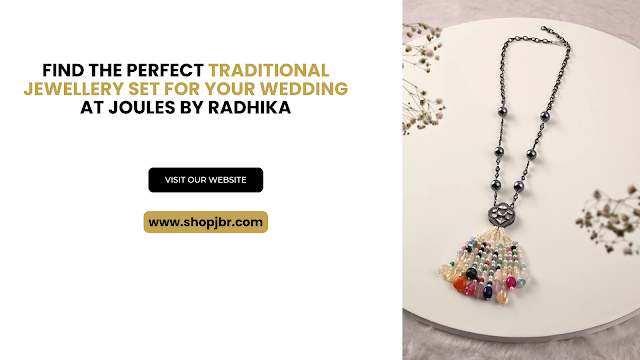Cultural Elegance: The Fusion of Tradition and Modernity in Indian Designer Jewellery
Introduction
In recent years, the
jewellery market has undergone a remarkable transformation, particularly in
India. With the rising popularity of Indian designer jewellery, consumers are increasingly seeking pieces that not
only reflect their individuality but also pay homage to their cultural
heritage. This post explores the current trends, market dynamics, and the
growing significance of branded jewellery in India, highlighting the factors
that contribute to their success. As we delve into the world of Indian designer
jewellery, we will examine its evolution, the allure of branded pieces,
emerging trends, and the promising future of this vibrant market.
1. The Evolution of Indian Designer
Jewellery
Indian designer jewellery
has evolved significantly, moving from traditional craftsmanship to
contemporary designs that cater to modern tastes.
- Traditional
Roots:
Traditionally, Indian jewellery was characterized by intricate designs,
often made using gold and precious gemstones. Each piece told a story,
reflecting the rich history and cultural significance of the region. For
centuries, jewellery was not merely an accessory; it held deep personal
and social meanings. In various cultures across India, jewellery was used
as a status symbol, a marker of wealth, and even a form of investment.
- Contemporary
Influence: Today,
designers blend traditional techniques with modern aesthetics, resulting
in pieces that are not only beautiful but also wearable. This fusion
appeals to a wider audience, particularly younger consumers who seek
unique and personalized pieces. Contemporary designers are experimenting
with unconventional materials, geometric shapes, and innovative designs,
making Indian jewellery relevant in today's fashion landscape.
- Market
Dynamics: The Indian
jewellery market is projected to grow significantly, driven by rising
disposable incomes and changing consumer preferences. According to a
recent market research report, the Indian jewellery market is expected to
reach approximately $100 billion by 2025. The demand for designer pieces
that embody both artistry and modernity is at an all-time high, fueled by
a burgeoning middle class and a growing interest in luxury goods.
2. The Significance of Branded Jewellery
Branded jewellery has become
a hallmark of luxury and quality, appealing to consumers looking for assurance
in their purchases.
- Trust
and Quality:
Established brands offer guarantees of quality and authenticity, which is
crucial in a market flooded with unverified sellers. Consumers are often
willing to pay a premium for the assurance that comes with branded
jewellery. This trust is vital for consumers when investing in high-value
items like jewellery, where authenticity can make a significant difference
in value.
- Luxury
Experience: Branded
jewellery provides an experience that goes beyond just the product. From
personalized customer service to exclusive collections, these brands cater
to a discerning clientele seeking more than just a piece of jewellery.
High-end retailers often offer bespoke services, allowing customers to
design their pieces or choose from limited-edition collections, enhancing
the luxury experience.
- Brand
Storytelling: Successful
jewellery brands often have compelling narratives that resonate with
consumers. They emphasize craftsmanship, heritage, and the story behind
each piece, creating an emotional connection that drives sales. This
storytelling approach not only highlights the uniqueness of each piece but
also fosters a sense of community among customers who identify with the
brand’s values.
3. Trends Shaping the Indian Designer
Jewellery Market
The Indian designer
jewellery market is influenced by various trends that reflect the changing
preferences of consumers.
- Sustainable
Practices: There is a
growing demand for ethical and sustainable jewellery. Designers are
increasingly sourcing materials responsibly and using eco-friendly
practices, appealing to environmentally conscious consumers. Sustainable
jewellery brands often highlight their commitment to ethical sourcing,
using recycled metals and ethically sourced gemstones, which resonates
with a new generation of consumers who prioritize sustainability in their
purchasing decisions.
- Customization
and Personalization:
Consumers are increasingly seeking unique pieces that reflect their
personality. Customization options, from choosing materials to designing
unique pieces, are gaining popularity. Brands are responding by offering
bespoke services that allow customers to co-create their jewellery,
ensuring that each piece is truly one-of-a-kind. This trend towards
personalization extends to engraving names or special dates on pieces, making
them sentimental gifts.
- Online
Shopping Experience: The
rise of e-commerce has revolutionized how consumers shop for jewellery.
Brands are investing in user-friendly websites and virtual try-on
features, making it easier for consumers to find and purchase their
desired pieces. The pandemic accelerated this shift, as more consumers
turned to online shopping for convenience and safety. Today, a robust
online presence is essential for jewellery brands, with many offering
exclusive online collections and discounts to attract customers.
4. The Future of Indian Designer and
Branded Jewellery
The future of Indian
designer jewellery looks promising, with several factors contributing to its
growth.
- Global
Recognition: Indian
designers are gaining international acclaim, showcasing their collections
at global fashion weeks and exhibitions. This exposure is helping to
elevate the status of Indian jewellery on the world stage. Collaborations
with international designers and participation in international
exhibitions are creating opportunities for Indian brands to reach a global
audience.
- Market
Expansion: As the
demand for Indian designer and branded jewellery continues to rise, brands
are exploring new markets, both domestically and internationally. This
expansion presents opportunities for growth and collaboration with global
designers. Many brands are investing in expanding their product lines to
cater to diverse consumer preferences, including bridal jewellery, statement
pieces, and everyday wear.
Conclusion
The landscape of Indian
designer jewellery is evolving rapidly, driven by consumer preferences for
authenticity, quality, and personalization. As the market continues to expand,
both Indian designer and branded jewellery will play a crucial role in shaping the future of the jewellery
industry. Brands that prioritize innovation and sustainability will thrive,
appealing to a new generation of consumers seeking to express their individuality
through their jewellery choices. With a strong foundation of cultural heritage
and a focus on contemporary trends, the future of Indian designer jewellery is
indeed bright.




Comments
Post a Comment